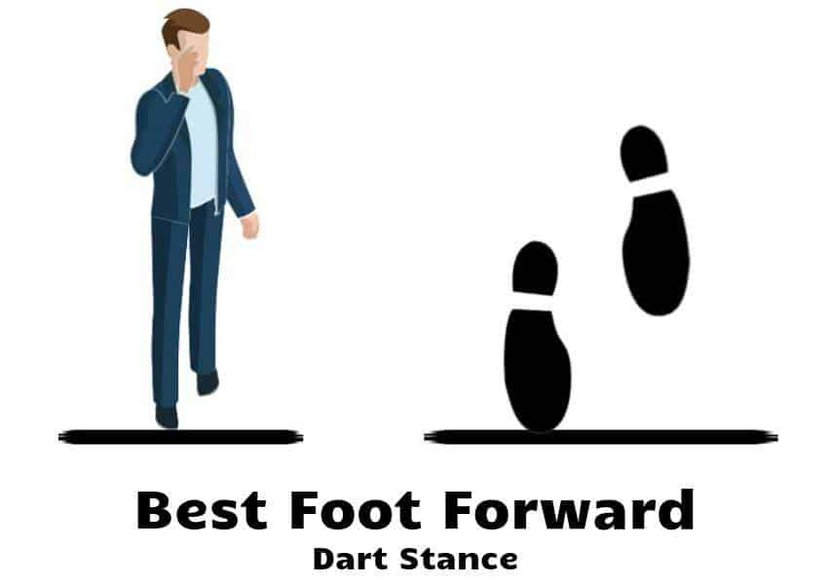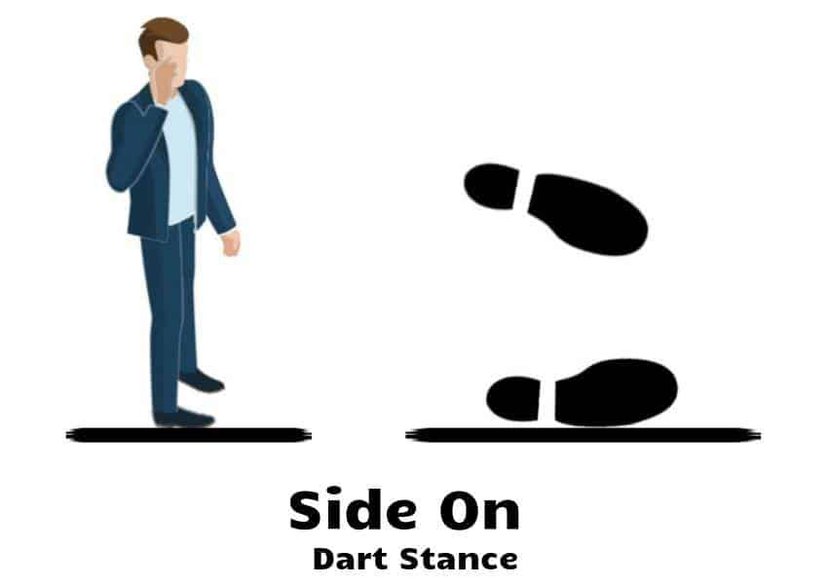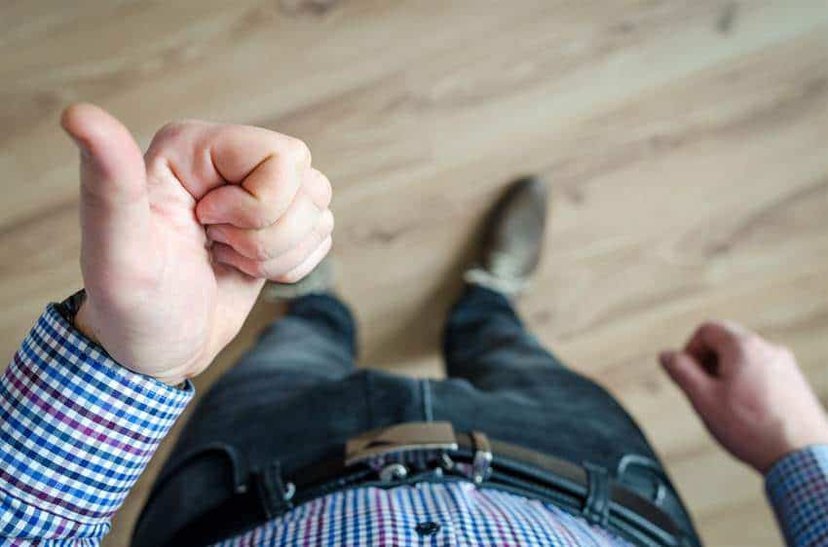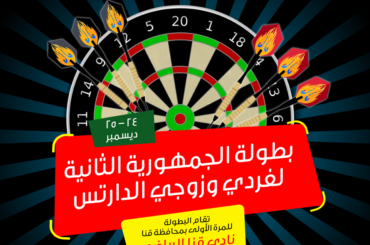Beginners are often enthusiastic about learning all the different tips, tricks, and details that are so important to mastering our beloved sport. Yet, for some reason, there is one question that many beginning players forget to ask, and that is, what is the correct dart stance?
A perfect dart stance is a combination of positioning and balance. You must position yourself in such a way that your body, eye, arm, and dart all line up with your target.
There are four common ways to stand while playing darts.
Front Facing Dart Stance
Best Foot Forward
Angled
Side-On
If you are looking for information on a specific stance, you can use the table of contents to jump ahead. But if you are having trouble with your positioning, I recommend reading on as we will be covering everything you need to know about how to improve your dart stance.
The mechanical aspects of the dart throw are belied by the simplicity of the game itself. On the surface, it looks like a simple action, but throwing a dart is a complex activity that involves the precise activation of an articulated system.
The forearm, arm, wrist, and hand must all act upon the dart itself to ensure the most accurate dart throw. If you are not balanced or positioned correctly that all goes out the window.
Introducing additional and unnecessary variables into the throw complicates the mechanics and increases the risk of throwing inaccurately. Therefore, special attention must be given to having a proper stance when we step up to the Oche.
What Is An Oche?
The Oche is the line, mark, or ridge on the floor behind which all players must stand to throw a dart. The Oche is also commonly referred to as the “throw line” or the “toe line.”
In other words, the Oche denotes the closest possible distance at which a player is allowed to stand in relation to the dartboard.
The name Oche has a winding history, with the first official uses registered sometime around the 1970s but whose historical origin dates much further back, perhaps to the days that Old Flemish was spoken.
Any discussion about proper stance has to acknowledge the Oche line because it will work as a point of reference.
Where to Stand When Throwing Darts?
Although the dimensions denoting the distances involved in the game of darts can vary widely across locales, for the most part, a standard has been set and is followed across all the official venues and competitions.
The dartboard is hung so that the center of the bullseye is set at a distance of 1.73 meters, or 5 feet 8 inches, from the floor. Make sure you hang your dartboard on a level wall; otherwise any variations in the surface level will affect the distance.
With the dartboard securely in place, measure a distance of 2.36 meters (7 feet 9 1/4 inches) from the face of the board. This is the officially recognized distance for the Oche line when playing steel-tipped darts. If done correctly, the total diagonal distance between the center bullseye and the Oche should be 2.93 meters, or 9 feet 7 3/8 inches.
It is important to note that when playing soft-tipped darts, the horizontal distance used to denote the Oche is slightly longer, measuring 2.4 meters (8 feet) from the board.
The Oche line should be no longer than 3 feet wide. It may be marked with tape, with a store bought sticker, a piece of wood or metal bar.
For a throw to be considered legitimate and legal, the throwing player must not, under any circumstances, extend any part of his or her feet past the edge of the Oche line closest to the board.
That is to say, the player’s feet may touch the line, but if any part of their feet extends beyond it, then the throw is to be considered invalid.
Now that we know where we stand let’s get into the nitty-gritty of what to do and how to do it.
Body Position When Throwing Darts
When you hear the word “stance,” you immediately think feet and legs, but really stance is your whole body position while standing. I cannot stress enough the fact that when we talk about stance, we should not just focus on our feet and legs.
That being said, foot position is an essential part of your stance. It will affect everything from your balance, angle, and distance to the board. We will start at the ground up and discuss how all the parts of your body affect your throw.
If you ask one hundred different players what is the correct stance to throw darts, the chances are that you would get at least seventy different answers. So before we tell you what we think is the best overall stance, let’s take a more detailed look at the mechanics behind it all.
Feet
Unless you are standing straight on, we must differentiate between our support foot and our balance foot.
Whether you are right-handed or left-handed, one foot should always carry more weight than the other. This foot is the support foot and will provide you with a solid base to ground your throw. The support foot is always the closest foot to the board and corresponds with the hand you throw your darts.
Never raise your support foot during a throw, not even a little bit.
The non-support foot is your back foot. It will provide you with balance so that your body’s natural sway is minimized. While some players also like to leave it firmly planted on the ground, it is best to raise it slightly forward and place its weight on the toes.
Not only does your back foot control your balance but moving it changes the position of your torso, affecting the angle at which you are throwing at the board. This is one of the most often overlooked elements of dart stance and a common culprit when darts are not hitting straight on.
The angle of attack for your support foot can vary between 45 degrees to 180 degrees. Anything beyond these values tends to throw your body off balance.
Legs
Both legs should remain straight during the throw. One of the most common mistakes made by beginners is to bend the knees. This is most likely a subconscious reaction with the purpose of adding some form of extra momentum to the dart at the moment of release.
You throw from the arm. Keeping your legs straight provides a stable, balanced foundation that will improve aim and accuracy.
Picture basketball a player shooting a free-throw; that is not what you want to do when you throw a dart. It is more like a photographer using a tripod to steady a shot.
As a side note, many players complain about tightness and pain in their calf muscles after long sessions of play because they unconsciously tense up when they throw. Try to keep your calf muscles relaxed, and remember the tension for the throw must come from your elbow and forearm.
Body
The player’s body should remain slightly tilted and somewhat inclined towards the target. In this manner you accomplish two things:
First, you shorten the distance to the board.
Second, you tighten essential muscles in your abdominal area, which help to focus your center of gravity.
Arms
Arms are an essential part of your posture because they function as a counterweight to give us added balance. Try walking without swinging your arms; you will see rapidly how awkward and lumbering it feels. By becoming conscious of our arm placement, not only will we have better throws, but we will also have a more balanced stance; which, in turn, feeds back into our throws. Thus, making us better players.
The upper part of your throwing arm should remain parallel to the floor, and when you throw only your elbow joint should become active. If you throw using your shoulders, you will swing your body off balance to the detriment of your accuracy.
Your non-dominant arm should remain relatively close to your body to help you tighten up your core.
At the end of your throw, the throwing arm should be fully extended in front of your body creating an angle of 180 degrees with the floor.
Different Types of Dart Stances
By correctly applying these principles we arrive at four main stances. Deciding which one is right for you will depend entirely on personal preference. Each one has advantages and disadvantages, but all four are perfectly sound.
Front Facing Dart Stance

In this stance both of the player’s feet face forward and touch the Oche line but do not extend beyond it. It has fallen out of popularity in recent years because it somewhat inhibits your ability to shorten the distance to the board.
Front facing stance does not allow the player much room to lean forward because doing so with both feet squared up will cause the player to shift his or her center of gravity a bit too much and lose balance in the process.
However, the front-facing stance is excellent for beginners because it is effortless to achieve.
Best Foot Forward Dart Stance

This is similar to the front facing stance as both feet are pointing towards the board. The difference here is the foot of your throwing arm would be on the oche and the other foot back further for balance.
This stance offers a position that is like the front facing stance with a little more leeway for leaning into the shot.
Angled Dart Stance

This position has us placing our front foot on the oche at an angle. There is no right or wrong angle and is entirely up to the player to decide what field comfortable.
The back foot must also be positioned at an angle but slightly off center. This stance is common because it provides more stability.
As with the best foot forward stance, the player has an easier time leaning forward and shortening the distance to the board without having to give up the balance to do it.
Side-On Dart Stance

A sideways stance is becoming more and more prevalent these days because it significantly minimizes unnecessary movement of the body and allows you to lean in farther.
In this instance, the player must stand completely sideways in relation to the board. This requires the player to twist at the waist, and this might be a little uncomfortable for some, so keep that in mind.
Anyone of these stances should serve as a solid foundation from which to develop a personal preference.
Considerations
Is It Ok To Lean Over the Line When Throwing Darts?
Leaning into a shot can have a substantial impact in your precision. While both feet must remain behind the oche, any other part of your body is free to lean over the line.
The farther you lean, the closer to your target you will be. This does come at the cost of balance, so it is essential to find a happy medium. Due to positioning, a sideways stance generally offers the most potential for leaning into a shot which is why it is so popular.
Finding your Dominant Eye
In our aiming article, we discuss the importance of determining your dominant eye. When you bring your dart up for aiming, you want to make sure you are doing it with the correct eye.
If your dominant eye is not the same as your throwing arm, a front facing or best foot forward stance may be for you. This will allow you to more naturally position the dart in front of your good eye while aiming.
Lunging When Throwing the Dart
It is common for new players to use their whole body when throwing a dart. Jumping up or lunging forward during a throw will change everything about where and how your dart is release and it will negatively affect your aim?
You cannot aim then move your body, and expect your dart to hit the target you were aiming at. You want your body to remain still throughout your throw. All movement should be in your arm only, primarily in your elbow and wrist.
The Position of Your Back Foot
In every stance except the front facing, the position of your back foot acts a balance, but that is not the only purpose. Moving your back foot to the left or right repositions your torso and changes the angle of your throw.
If you find your darts are drifting to the left or right, try re-positioning your back foot to change the angle that you are facing the board.
So How Do You Stand When Playing Darts?
Stand in a position that feels natural but don’t be afraid to experiment. The most popular dart stance is without a doubt is the sideways stance.
Standing sideways allows your front leg to be directly above the oche and thus your shoulder as well. Putting the weight on your front foot and using the rear as balance allow you to lean far pass the throw line.
Also commonly seen are players who lift the ankle of their rear foot, leaving only the toe of the shoe in contact with the floor. Much less common are players who keep both feet firmly planted.
On the angles between the right foot and the line, there are many variations. Some players meticulously place their feet parallel to the line and then twist or bend their bodies at the waist so that they can aim straight at the target.
Other players line up their feet perpendicular to the Oche line, with their toes pointed in the direction of the dartboard. Some players will, to their detriment, lift their rear foot in the air right when they throw.
It is common to see professionals use stances that are a mix of these three. However, beginners should remain vigilant about picking up bad habits when developing their preferred posture.
For example, leaning forward too much can throw your body’s balance off-kilter. Additionally, a forward-leaning stance tends to put extra pressure on the muscles of the lower back, so keep that in consideration.
Dart Stance Tips
Here are some tips to ensure your stance is as good as the ones used by the pros
Remember to line up. Using the center bullseye as a point of reference, draw an imaginary line extending from the board to the Oche. Learn to line up with this center consistently, and you will see your scores improve.
Always keep your weight distributed on both feet. While the front foot can support up to 75% of your total body weight, you should never lift your back foot entirely off the ground.
Don’t give up balance for leaning. A solid footing is the foundation of a good throw.
Final Words

If you are at all serious about improving as a player do not overlook your stance. In every sport where there is a throwing component, the players have developed specific wind-ups and positions that maximize results while minimizing effort; this is extremely important because it helps to reduce fatigue over extended periods of play.
Baseball pitches, football passes, and basketball free-throws all require a careful and conscientious stance; dart throws are no different.
Whether you choose to throw using facing head-on, sideways, or anything in between, make sure that your feet are set about shoulder-width apart and that every part of your body works in conjunction with you.
Be aware of every move you make and remember to breathe. Holding your breath causes unnecessary tension, and it can completely mess up your game.
Most importantly, have fun and never stop practicing!




